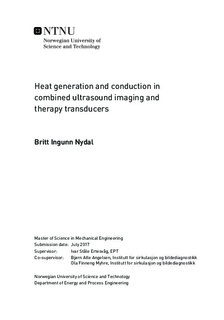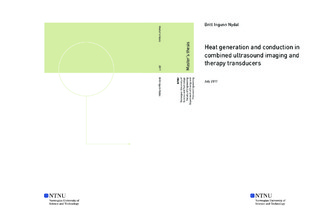| dc.description.abstract | In this thesis, the heat sources and heat transfer in high power, multifrequency transducers to be used for both ultrasound imaging and mediation of drug delivery, are studied.
Electrical energy is converted into acoustic energy in a transducer, and in this process, due to acoustic energy absorption, some energy is also converted to thermal energy. With higher frequency, these heat sources are larger, and it can lead to overheating of the transducer. A 9 MHz probe is used in this project, and the heat sources are calculated in the program x-trans.
In the transducer, we have conduction in the layers and convective heat transfer between the transducer and the surroundings. Radiation is neglected in the simulations. The heat transfer is simulated using the software Comsol Multiphysics.
The results show that the temperature development in the transducer in the first 10 seconds of usage is transient or unsteady. The internal energy generation is larger than the convection rates with the surroundings. The highest temperature in the transducer is measured in the matching layers, which are on the face, with a value of 336.8 K for the transducer used today. The real temperature rise, with a temperature of 381 K, happens in the load, which is the body of the patient. The critical parameter in limiting internal temperature is the heat source in the load.
Some different transducer geometries are tested in order to see how it affects the temperature distribution. The geometry with the largest backing layer is measured to have the lowest maximum temperature in the transducer. The temperature is measured as 310.3 K in the transducer and 379.4 K in the load. Also, the use of fans to cool the transducer is simulated, in addition to a heat sink method that consists of copper slabs. Based on the simulations, the slabs are most effective in cooling the transducer. The temperature is measured as 314 K in the transducer, and 366.8 K in the load. | |

